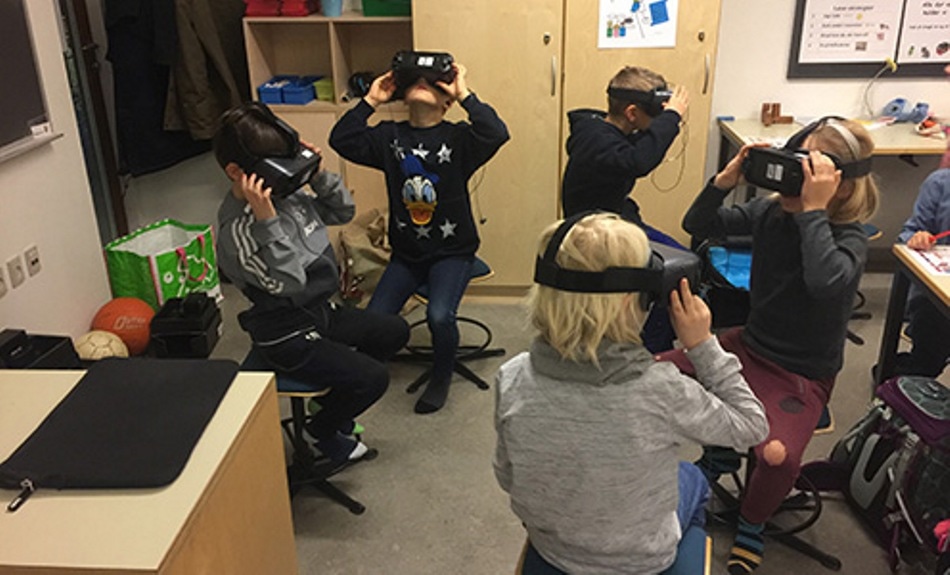Jan 9 2019
Whether it is a normal classroom or a virtual learning environment, the teacher is just as significant in both settings.
 School kids with VR-glasses (Image credit: University of Copenhagen)
School kids with VR-glasses (Image credit: University of Copenhagen)
However, a recent study has demonstrated that girls and boys differ considerably in terms of how they learn best: VR-teaching enables girls to gain more knowledge, especially when they are taught by a young, female researcher-type called Marie, whereas boys learn best when they are taught by a virtual teacher in the form of a drone.
Several years from now, students in schools throughout the world will get part of their education in virtual learning environments. With the help of VR-goggles, the students will be able to enter simulated, 3-dimensional (3D) situations and places that normally cannot be accessed by them because it would be too dangerous, too costly, or physically impossible. Of late, teaching through VR-technology is spreading extensively, and according to international studies, this will transform the way people learn things.
With the help of VR, students will be able to learn about the cells present in the human body while “traveling” into the bloodstream, or “exploring” the extent of plastic pollution in the oceans. Students can also perform challenging experiments using dangerous chemicals and costly laboratory equipment, simply by putting on a pair of VR-goggles that instantly provides lively and extremely realistic experiences.
A number of these reports have revealed that over the next two-three years, the cost of VR-technology will be reduced to such an extent that it will be included in daily classroom teaching for about 15 million students across counties before 2025. This prediction is backed by tech-giants like Samsung, Apple, and Google that are making huge investments in designing VR for teaching.
However, the rapid development of VR-technology in teaching is considered as a new and somewhat untested field. Therefore, Guido Makransky, an Associate Professor in Psychology at the University of Copenhagen, explores how, why, and in what situations VR-learning offers a benefit over conventional media and methods, so that society’s investments in VR-technology can be utilized in the most advantageous manner.
Our studies show that VR-learning where students train certain skills via simulations can be more effective than regular classroom teaching or learning via computers, and that it motivates and engages students more and heighten their self-efficacy. However, we need more information on when and how teaching via VR-simulations is an advantage, so we can steer clear of thoughtless investments in technology just for the sake of investing in technology without any real benefits in terms of better learning.
Guido Makransky, Associate Professor¸ Department of Psychology, University of Copenhagen.
Guido Makransky has a particular interest in the pedagogical factors of VR-learning. In earlier analyses, he has tested the cognitive and emotional learning processes of hundreds of university and high school students through electroencephalography (EEG) and by registering their eye-tracking, sweat-responses (GSR), and facial expressions.
A virtual role model
Since the year 2014, Makransky has recorded in numerous studies that VR-learning in specific situations is not only more engaging, but can also lead to more improved learning outcomes when compared to conventional techniques. In addition, his new study demonstrates that the learning aspects in boys and girls differ considerably based on the appearance and form of the so-called pedagogical agent, virtual teacher.
A study involving 66 students from 7th and 8th grades (half girls, half boys) was performed at a Danish science talent school. In this study, Makransky and colleagues discovered that the VR-simulations enabled the girls to learn more, especially when the VR-teacher was a young, female researcher called Marie; on the other hand, the boys in the study learned best when the pedagogical agent instructing them happened to be a flying robot in the form of a drone.
We can see that students’ ability to identify with the pedagogical agent improves their level of learning. This gives us an exciting possibility to actually make education more appealing to the students. This is important as children’s interest in school decreases in middle school, and there is specifically a desire to increase female students’ interest, in science, technology, engineering and maths (STEM) subjects. Therefore, the possibility to engage girls is very appealing. In our opinion VR-program designers should use this knowledge to incorporate different types of pedagogical agents in VR for different types of students. Our results show, that the boys’ concentration and focus on the task rises when their virtual teacher is a non-traditional teaching figure like a robot or a drone. We also see these types of pedagogical agents are more effective in terms of the boys’ learning outcomes, possibly because they portray some of the superhero-qualities, that appeal widely to boys, and because they resemble the agents, boys are used to interact with in computer games.
Guido Makransky, Associate Professor¸ Department of Psychology, University of Copenhagen.
Other aspects of VR-teaching examined
If the students are younger, it appears to be more important that they can relate to their VR-teacher. For example, when university students are instructed by a figure resembling themselves, they did not appear to learn better, while the ability to reflect oneself in the teaching figure has been identified as being extremely significant for students in middle school classes.
However, many unanswered questions still remains with regards to VR-learning, added Guido Makransky, who is now leading a project funded by the Danish Innovation Fund where he and his colleagues at the University of Copenhagen Virtual Learning Lab are studying several other aspects of when it is most advantageous for schools to apply VR-for teaching and how one can design VR-learning experiences that actually add value to education and work well in a classroom environment.